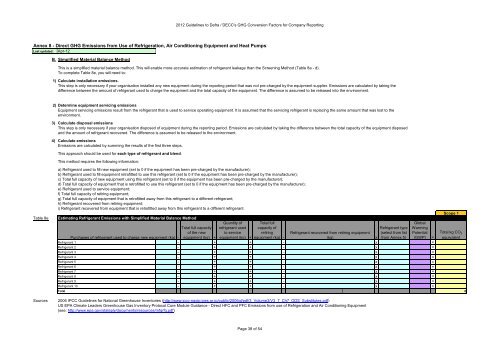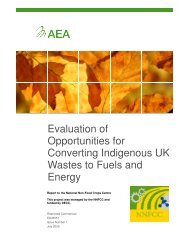Greenhouse gas conversion factors for company reporting
Greenhouse gas conversion factors for company reporting
Greenhouse gas conversion factors for company reporting
You also want an ePaper? Increase the reach of your titles
YUMPU automatically turns print PDFs into web optimized ePapers that Google loves.
2012 Guidelines to Defra / DECC's GHG Conversion Factors <strong>for</strong> Company Reporting<br />
Annex 8 - Direct GHG Emissions from Use of Refrigeration, Air Conditioning Equipment and Heat Pumps<br />
Last updated: Apr-12<br />
B. Simplified Material Balance Method<br />
This is a simplified material balance method. This will enable more accurate estimation of refrigerant leakage than the Screening Method (Table 8a - d).<br />
To complete Table 8e, you will need to:<br />
1) Calculate installation emissions.<br />
This step is only necessary if your organisation installed any new equipment during the <strong>reporting</strong> period that was not pre-charged by the equipment supplier. Emissions are calculated by taking the<br />
difference between the amount of refrigerant used to charge the equipment and the total capacity of the equipment. The difference is assumed to be released into the environment.<br />
Table 8e<br />
Sources<br />
2) Determine equipment servicing emissions<br />
Equipment servicing emissions result from the refrigerant that is used to service operating equipment. It is assumed that the servicing refrigerant is replacing the same amount that was lost to the<br />
environment.<br />
3) Calculate disposal emissions<br />
This step is only necessary if your organisation disposed of equipment during the <strong>reporting</strong> period. Emissions are calculated by taking the difference between the total capacity of the equipment disposed<br />
and the amount of refrigerant recovered. The difference is assumed to be released to the environment.<br />
4) Calculate emissions<br />
Emissions are calculated by summing the results of the first three steps.<br />
This approach should be used <strong>for</strong> each type of refrigerant and blend.<br />
This method requires the following in<strong>for</strong>mation:<br />
a) Refrigerant used to fill new equipment (set to 0 if the equipment has been pre-charged by the manufacturer);<br />
b) Refrigerant used to fill equipment retrofitted to use this refrigerant (set to 0 if the equipment has been pre-charged by the manufacturer);<br />
c) Total full capacity of new equipment using this refrigerant (set to 0 if the equipment has been pre-charged by the manufacturer);<br />
d) Total full capacity of equipment that is retrofitted to use this refrigerant (set to 0 if the equipment has been pre-charged by the manufacturer);<br />
e) Refrigerant used to service equipment;<br />
f) Total full capacity of retiring equipment;<br />
g) Total full capacity of equipment that is retrofitted away from this refrigerant to a different refrigerant;<br />
h) Refrigerant recovered from retiring equipment;<br />
i) Refrigerant recovered from equipment that is retrofitted away from this refrigerant to a different refrigerant.<br />
Estimating Refrigerant Emissions with Simplified Material Balance Method<br />
Total full capacity<br />
of the new<br />
equipment (kg) +<br />
Quantity of<br />
refrigerant used<br />
to service<br />
equipment (kg) +<br />
Total full<br />
capacity of<br />
retiring<br />
equipment (kg) -<br />
Refrigerant recovered from retiring equipment<br />
Refrigerant type<br />
(select from list<br />
from Annex 5)<br />
Global<br />
Warming<br />
Potential<br />
(GWP) =<br />
Scope 1<br />
Total kg CO 2<br />
equivalent<br />
Purchases of refrigerant used to charge new equipment (kg) -<br />
(kg)<br />
x<br />
Refrigerant 1 - + + - x =<br />
Refrigerant 2 - + + - x =<br />
Refrigerant 3 - + + - x =<br />
Refrigerant 4 - + + - x =<br />
Refrigerant 5 - + + - x =<br />
Refrigerant 6 - + + - x =<br />
Refrigerant 7 - + + - x =<br />
Refrigerant 8 - + + - x =<br />
Refrigerant 9 - + + - x =<br />
Refrigerant 10 - + + - x =<br />
Total 0<br />
2006 IPCC Guidelines <strong>for</strong> National <strong>Greenhouse</strong> Inventories (http://www.ipcc-nggip.iges.or.jp/public/2006gl/pdf/3_Volume3/V3_7_Ch7_ODS_Substitutes.pdf)<br />
US EPA Climate Leaders <strong>Greenhouse</strong> Gas Inventory Protocol Core Module Guidance - Direct HFC and PFC Emissions from use of Refrigeration and Air Conditioning Equipment<br />
(see: http://www.epa.gov/stateply/documents/resources/mfgrfg.pdf)<br />
Page 38 of 54








